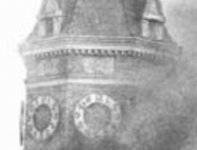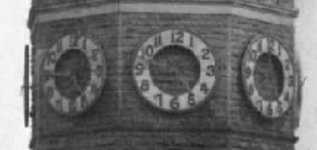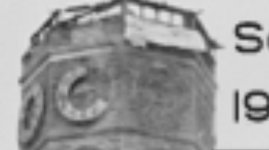I am not particularly interested in the history of the buildings located on the Washington State campus in Olympia. Well, I have not been up to this point. The construction process of these buildings is pretty well documented, and has plenty of photographs. This is especially true for the Legislative building (below).

Washington State CapitolThe Washington State Capitol or Legislative Building in Olympia is the home of the government of the state of Washington. It contains chambers for the Washington State Legislature and offices for the governor, lieutenant governor, secretary of state and treasurer and is part of a campus consisting of several buildings. Buildings for the Washington Supreme Court, executive agencies and the Washington Governor's Mansion are part of the capitol campus.
After Olympia became capital city of the Washington Territory in 1853, the city's founder, Edmund Sylvester, gave the legislature 12 acres (4.9 ha) of land upon which to build the capitol, located on a hill overlooking what is now known as Capitol Lake.
A two-story wood-frame building was constructed on the site, where the legislature met starting in 1854.

When President Benjamin Harrison approved Washington's state constitution in 1889, he donated 132,000 acres (530 km2) of federal lands to the state with the stipulation that income from the lands was to be used solely for construction of the state capitol.

1857-1947
In 1891, Flagg began his architectural practice in New York, greatly influenced by his knowledge of the French ideas of architectural design, such as structural rationalism.
The Capitol Campus was placed on the National Register of Historic Districts in 1974 and contains or contributes to some of the most valued views in the State including the Olympic Mountains, Puget Sound, Mt. Rainier, the Capitol Dome and the Capitol Group of buildings on the hill. The design of the Capitol Campus is a grand example of the City Beautiful style of the Progressive era of the early 20th Century.

Naturally, this could be rather strange. I am not saying that photographs of these two architects do not exist, but it's rather bizarre not to have those easily available on the internet. After all, structures attributed to them are pretty magnificent. It's not like they died that long ago.
At the same time, I have this feeling that everything is not as straight forward as it appears to be. Several days ago I had a wonderful opportunity to spend some time in the Legislative Building.

To me, it looks like something much older was being destroyed. Though the below image from the UW Digital Library suggests that we are seeing (above) some early Legislative Building foundation works.

The Old Capitol BuildingAs we already know, from 1905 until 1928, the Thurston County Courthouse served as the Washington State Capitol. The Old Capitol Building was (and is) located not far from the New Capitol Building.
The Old Capitol Building is a building in Olympia, Washington. Designed by Willis A. Ritchie, it was built from 1890 to 1892 as the Thurston County Courthouse, and served from 1905 until 1928 as the state capitol, seat of the legislature of Washington; in 1928 the legislature moved to the current Capitol Building. It is now the office of the Superintendent of Public Instruction.
The building has survived several disasters, after each of which it has been repaired. A fire in 1928 resulted in the loss of a central tower.
I am not sure how much of the original Old Capitol building was destroyed by the actual fire. The below image suggests the destruction was not as extensive as the above image suggests. May be some re-building demolition activities contributed to what we can see on the above photograph.

Here is what the narrative says about damages. The clock tower looked like a big chimney, billowing smoke and flames, but the clockwork mechanism continued running. At times, it appeared as though the high tower might collapse, but it stayed upright, and the clocks stopped one at a time. The last clock stopped at 4:47 p.m., when a fire hose hit the dial with a blast of water. By 5:00 p.m., through the combined efforts of both fire departments and citizen volunteers, the blaze was brought under control and by 5:30 p.m. completely extinguished.
KD: I added the Old Capitol building to this article in order to make the story more complete, if you will. It's the location where the New Capitol building was built that I'm interested in. I will re-post the photograph I snapped at the Capitol. A very similar UW Digital Archives photograph was titled:

What do you think? Were there any pre-existing structures where the new Washington State Capitol building was built?
- Washington State Capitol
- Olympia Capitol - A History of the Building
- Capitol facts & history
- History of the Legislative Building
Washington State Capitol
After Olympia became capital city of the Washington Territory in 1853, the city's founder, Edmund Sylvester, gave the legislature 12 acres (4.9 ha) of land upon which to build the capitol, located on a hill overlooking what is now known as Capitol Lake.
A two-story wood-frame building was constructed on the site, where the legislature met starting in 1854.
- Pencil sketch of the old Territorial capitol building, Olympia, 1876
- Source
When President Benjamin Harrison approved Washington's state constitution in 1889, he donated 132,000 acres (530 km2) of federal lands to the state with the stipulation that income from the lands was to be used solely for construction of the state capitol.
- The legislature formed the State Capitol Commission in 1893 to oversee the creation of a new capitol on the property in Olympia.
- The commission had a nationwide competition to find an architect and chose the submission of Ernest Flagg.
Earnest Flagg
Ernest Flagg was a noted American architect in the Beaux-Arts style. He was also an advocate for urban reform and architecture's social responsibility.- Flagg was born in Brooklyn, New York.
- His father Jared Bradley Flagg was an Episcopal priest and a notable painter.
- Ernest left school at 15 to work as an office boy on Wall Street.
- After working with his father and brothers in real estate for a few years, he designed duplex apartment plans in 1880 with the architect Philip Gengembre Hubert, for the co-operative apartment buildings Hubert was known for.
- Cornelius Vanderbilt II, Flagg's cousin through his marriage to Alice Claypoole Gwynne, was impressed by Flagg's work and sent him to study at the École des Beaux-Arts in Paris from 1889–1891, under his patronage.
1857-1947
In 1891, Flagg began his architectural practice in New York, greatly influenced by his knowledge of the French ideas of architectural design, such as structural rationalism.
- bla-bla-bla...
- Ernest Flagg - Wikipedia
- Rogers advocated the purchase of the existing Thurston County Courthouse in downtown Olympia, now known as the "Old Capitol" and home to the Office of Superintendent of Public Instruction.
- The legislature approved the new location and began meeting there in 1905.
- The courthouse became the location of all agencies of the state government and within a few years the legislature decided the building was too small and a new State Capitol Commission convened in 1911.
- Wilder and White's designs were influenced by the Olmsted brothers who served as consultants from 1911 to 1912 and designed and supervised the landscaping for the campus from 1927 to 1931.
- Construction of the campus began in 1912, and the Temple of Justice was completed in 1920, followed by the Insurance Building and the power and heating plant.
- After multiple revisions of the plans, the Legislative Building was completed in 1928.
- Additional buildings on the campus were constructed during the next several decades.
The Capitol Campus was placed on the National Register of Historic Districts in 1974 and contains or contributes to some of the most valued views in the State including the Olympic Mountains, Puget Sound, Mt. Rainier, the Capitol Dome and the Capitol Group of buildings on the hill. The design of the Capitol Campus is a grand example of the City Beautiful style of the Progressive era of the early 20th Century.
Walter Wilder and Harry White
Sounds like Wilder and White were the architect who allegedly designed the WA campus. For starters, these two esteemed gentlemen have no Wikipedia pages dedicated to them. At least I was unable to find any. Here is some info you might find interesting:- Wilder and White concentrated primarily on residential design, but did some notable public buildings in and around New York, NY.
- One of their biggest commissions was for the Washington State Capitol Building #3, Olympia, WA, 1911-1928.
- Norman Johnston observed of the two architects' practice:
- The two men maintained a stable professional relationship, though their physically separated domestic arrangements discouraged social contact.
- Wilder may have been more of the designer.
- White filling a managerial and production role.
- But decisions were made in easy give-and-take discussions between them; their association was a close one over the years of their partnership. Both did contact work in search of clients; in this White may have been the more successful, as many of their larger commissions were for schools and institutions in the Plainfield [NJ] area."
- See Norman J. Johnston, Washington's Audacious State Capitol and Its Builders, [Seattle: University of Washington Press, 1988]
- Walter Robb Wilder: 1875-1934
- Harry Keith White: 1877-1966
Construction
Just like I mentioned before, the construction of the main campus buildings has no shortage of photographs. You can follow the below link and see for yourselves.At the same time, I have this feeling that everything is not as straight forward as it appears to be. Several days ago I had a wonderful opportunity to spend some time in the Legislative Building.
- Below you can see one of the photographs displayed next to the souvenir shop inside.
- There were more photographs on the wall, but they fall in line with the narrative and are available here.
- Construction progress on Legislative Building showing early foundation work, Washington State Capitol complex construction, Olympia, September 16, 1923
The Old Capitol Building
The Old Capitol Building is a building in Olympia, Washington. Designed by Willis A. Ritchie, it was built from 1890 to 1892 as the Thurston County Courthouse, and served from 1905 until 1928 as the state capitol, seat of the legislature of Washington; in 1928 the legislature moved to the current Capitol Building. It is now the office of the Superintendent of Public Instruction.
The building has survived several disasters, after each of which it has been repaired. A fire in 1928 resulted in the loss of a central tower.
- After the 1949 Olympia earthquake, the building was evacuated and suffered severe damage to its masonry exterior that had to be repaired over the following few months at a cost of $1.1 million.
- 10 of the 12 towers were lost in the earthquake, along with a rotunda, the House chamber, and several galleries in the East Wing.
- Water directed onto the roof merely splashed off the ornamental metal roofing, making it impossible to combat the blaze from outside.
- Firefighters ran hose lines inside the building and fought their way down corridors and up stairways.
- Several firefighters were overcome by smoke and had to evacuate the building.
- Ankle-deep water, falling plaster and burning debris added to the difficulty. But the only effective firefighting was being accomplished from inside the building.
- Engine Company No. 8 responded with a full compliment of firefighters and equipment, making the 32-mile run down Pacific Highway (US 99, later SR 99) in heavy Saturday afternoon traffic in 35 minutes.
- Upon arrival, the Tacoma firemen carried their hoses onto the roof by ladder, punched holes through the roof into the attic and began attacking the flames from above.
I am not sure how much of the original Old Capitol building was destroyed by the actual fire. The below image suggests the destruction was not as extensive as the above image suggests. May be some re-building demolition activities contributed to what we can see on the above photograph.
- Apologies for the quality of the below photograph. It was the largest one I could find.
Here is what the narrative says about damages. The clock tower looked like a big chimney, billowing smoke and flames, but the clockwork mechanism continued running. At times, it appeared as though the high tower might collapse, but it stayed upright, and the clocks stopped one at a time. The last clock stopped at 4:47 p.m., when a fire hose hit the dial with a blast of water. By 5:00 p.m., through the combined efforts of both fire departments and citizen volunteers, the blaze was brought under control and by 5:30 p.m. completely extinguished.
- Early Sunday morning, crews of workmen began clearing away debris and moving office furnishings and records to new quarters in the undamaged east wing.
- The southwest corner of the third floor sustained the worst damage.
- The roof had been destroyed there, exposing the Department of Public Works offices to the elements.
- The chief damage to the interior of the building was done by water which seeped into the offices below and cascaded down the stairways and elevator shafts into the basement.
- Engineers found the internal structure of the building to be sound and the masonry undamaged, but the foundation of the clock tower was unstable and the tower had to be removed.
- Repair work on the historic building was scheduled to begin at once.
- Source
KD: I added the Old Capitol building to this article in order to make the story more complete, if you will. It's the location where the New Capitol building was built that I'm interested in. I will re-post the photograph I snapped at the Capitol. A very similar UW Digital Archives photograph was titled:
- Construction progress on Legislative Building showing early foundation work, Washington State Capitol complex construction, Olympia.
What do you think? Were there any pre-existing structures where the new Washington State Capitol building was built?




